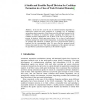293 search results - page 7 / 59 » Computing Stable Models by Using the ATMS |
NECO
2008
13 years 8 months ago
2008
The functions of sleep have been an enduring mystery. Recently, Tononi and Cirelli hypothesized that one of the functions of slow-wave sleep is to scale down synapses in the corte...
ATAL
2001
Springer
14 years 1 months ago
2001
Springer
In the last few years the use of coalition formation algorithms in multi-agent systems has been proposed as a possible way of modelling autonomous agent cooperation. Game theory pr...
SCL
2010
13 years 7 months ago
2010
In this paper we show that incrementally stable nonlinear time–delay systems admit symbolic models which are approximately equivalent, in the sense of approximate bisimulation, ...
BIOINFORMATICS
2008
13 years 8 months ago
2008
Motivation: For many biotechnological purposes, it is desirable to redesign proteins to be more structurally and functionally stable at higher temperatures. For example, chemical ...
CVPR
2007
IEEE
14 years 10 months ago
2007
IEEE
This paper introduces a novel colour-based affine covariant region detector. Our algorithm is an extension of the maximally stable extremal region (MSER) to colour. The extension ...

